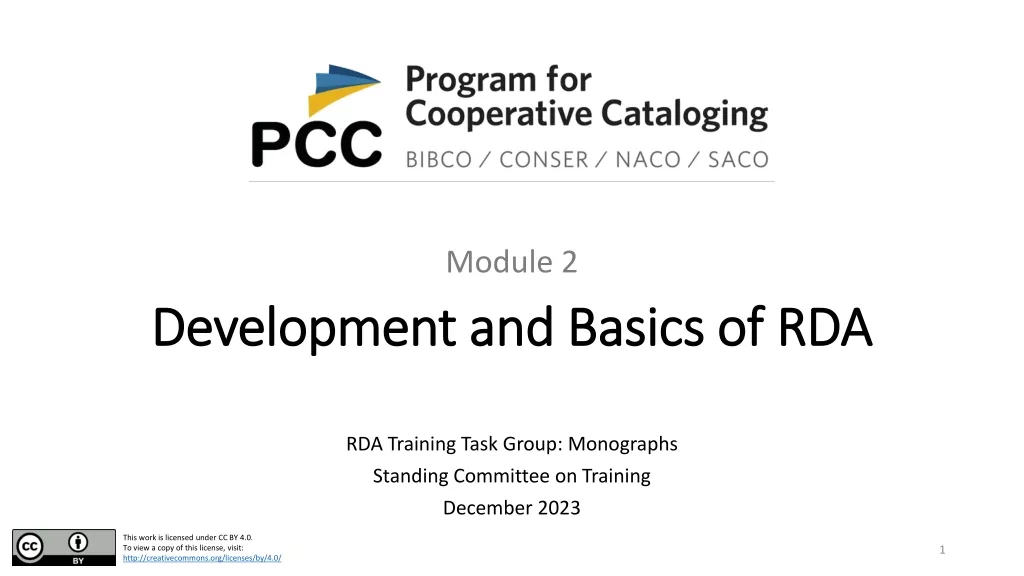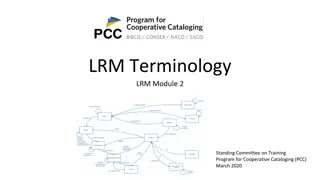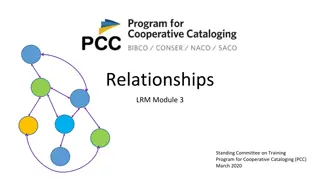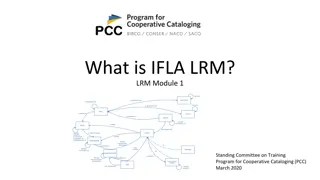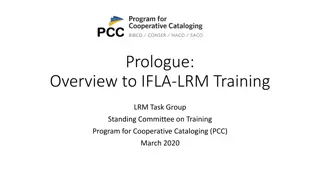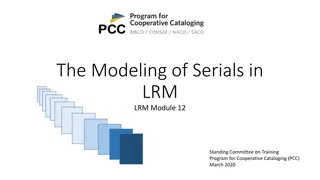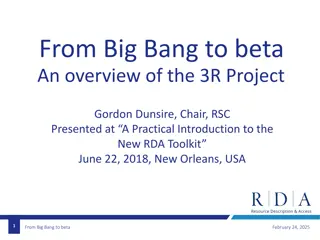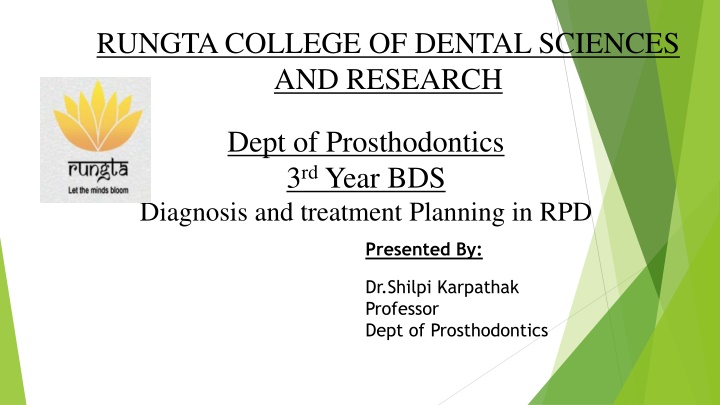
Diagnosis and Treatment Planning for Partially Edentulous Patients
Effective diagnosis and treatment planning for oral rehabilitation of partially edentulous mouths involve thorough patient history, diagnostic examination, and treatment plan development. Key considerations include caries and periodontal disease control, restoration of individual teeth, occlusal harmony, and replacement of missing teeth with fixed or removable prostheses. This process encompasses understanding patient concerns, assessing dental needs, creating a tailored treatment plan, and executing it with follow-up care.
Uploaded on | 1 Views
Download Presentation

Please find below an Image/Link to download the presentation.
The content on the website is provided AS IS for your information and personal use only. It may not be sold, licensed, or shared on other websites without obtaining consent from the author. If you encounter any issues during the download, it is possible that the publisher has removed the file from their server.
You are allowed to download the files provided on this website for personal or commercial use, subject to the condition that they are used lawfully. All files are the property of their respective owners.
The content on the website is provided AS IS for your information and personal use only. It may not be sold, licensed, or shared on other websites without obtaining consent from the author.
E N D
Presentation Transcript
RUNGTA COLLEGE OF DENTAL SCIENCES AND RESEARCH Dept of Prosthodontics 3rd Year BDS Diagnosis and treatment Planning in RPD Presented By: Dr.Shilpi Karpathak Professor Dept of Prosthodontics
Specific Learning Objective Core areas Domain Category Introduction General Information Medical history Dental history Cognitive Must Know Intraoral examination Hard tissue examination Soft tissue examination Cognitive Must Know Psychomotor Must Know Treatment planning Summary References Affective Must Know
Contents Introduction General Information Medical history Dental history Intraoral examination Hard tissue examination Soft tissue examination Treatment planning Summary references
Introduction Diagnosis and treatment planning for oral rehabilitation of partially edentulous mouths is an important step and must take the following into consideration control of caries and periodontal disease, restoration of individual teeth, provision of harmonious occlusal relationships and the replacement of missing teeth by fixed (natural teeth/implants) or removable prosthesis.
The uniqueness of the ultimate treatment of a partially edentulous patient occurs through recording patient history and diagnostic clinical examination including radiographs, mounted and surveyed diagnostic casts, a definitive oral examination, including periodontal probing, percussion and vitality test and appropriate medical and dental consultations.
This includes four distinct processes (i) understanding the patient s chief complaints/concerns, (ii) ascertaining the patients dental needs through a diagnostic clinical examination, (iii) developing a treatment plan that reflects the best management of the desires and needs (iv) execution of the treatment plan with follow-up.
History-The general, medical and dental history is obtained. General history- Age Provides a reference for the physiological status of patient. Neuromuscular skills diminish with age and ability to adapt to new situations is decreased. With age, oral epithelium becomes dehydrated and loses its elasticity resulting in decreased resistance to trauma. Salivary flow decreases with age leading to greater risk of caries.
Sex In females, menopause may be associated with hormonal imbalances which can cause osteoporosis and atrophy of oral epithelium. Pregnancy can have a bearing on the type of prosthesis.
Occupation Interim and immediate partial dentures may need to be considered depending on the occupation.
Medical history The systemic health and the drugs taken by the patient may affect removable partial denture treatment. Systemic diseases Common systemic disturbances that can have a significant effect on the treatment of the patient include the following: 1. Diabetes Uncontrolled diabetes is characterized by xerostomia, macroglossia and rapid periodontal breakdown. They also bruise easily and heal slowly. This significantly reduces the ability of the patient to wear prosthesis with comfort and increases the possibility that caries will occur. 2. Arthritis If arthritic changes occur in the temporomandibular joint, recording jaw relation can be difficult and changes in the occlusion may occur.
3. Anaemia These patients have a pale mucosa, sore tongue, xerostomia and gingival bleeding. Wearing a removable prosthesis will be more difficult for them. 4. Epilepsy Any seizure may result in fracture and aspiration of the prosthesis, and possibly the loss of additional teeth. Consultation with the patient s physician is essential before treatment is initiated. The construction of removable partial dentures is usually contraindicated if the patient has frequent, severe seizure with little or no warning. All material used in the construction of a prosthesis for an epileptic patient must be radiopaque so that any part of the prosthesis that is accidentally aspirated or swallowed during a seizure can be located radiographically. If the patient s medication includes diphenylhydantoin (dilation), one must take particular care to ensure that the removable partial denture does not irritate the gingival tissues, or hypertrophy of these tissues may result.
5. Cardiovascular disease Patients with the following symptoms require medical approval before any dental procedures: i. Acute or recent myocardial infarction ii. Unstable or recent onset of angina pectoris iii. Congestive heart failure iv. Uncontrolled arrhythmia v. Uncontrolled hypertension
6. Cancer -Oral complications are also common side effects of radiation and chemotherapy for malignancies in areas other than the head and neck (oral malignancy). The most common oral complications are mucosal irritations, xerostomia, and bacterial and fungal infections. These symptoms will complicate the construction and wear of a removable partial denture.
7. Transmissible disease Hepatitis, tuberculosis, influenza and other transmissible disease pose a particular hazard for the dentist, patients and dental auxiliaries. These diseases may be transmitted by contact with the patient s blood or saliva, contaminated dental instruments and aerosol from the handpiece. Contaminated impression trays, materials, polishing wheels, pumice as well as grindings from the patient s prosthesis may cause aerosol contamination of both the laboratory and the dental office.
Drugs 1. Anticoagulants Postsurgical bleeding could be a problem for patients receiving anticoagulants who undergo extractions or soft tissue or osseous surgery. These patients should be referred to an oral surgeon for the management of the surgical phases of treatment. 2. Antihypertensive agents The most significant side effect of the antihypertensive drugs is must be taken when the patient gets up from dental chair. Another fact to consider is that treatment for hypertension usually includes prescription of a diuretic agent, which can contribute to a decrease in saliva and an associated dry mouth.
3. Endocrine therapy Patients receiving endocrine therapy may develop an extremely sore mouth. If the patient is wearing prosthesis, it could incorrectly be blamed for causing the discomfort. 4. Saliva-inhibiting drugs Methantheline bromide (Banthine), atropine and their derivatives are sometimes used to control excessive salivary secretion, particularly when it is necessary to make accurate impression. They are generally contraindicated for use in patients with cardiac disease because of their vagolytic effect. Other contraindication for this disease includes prostatic hypertrophy and glaucoma. Saliva should be controlled by mechanical means in these patients.
Dental history 1. Reason for tooth loss: If teeth were lost due to periodontal disease, prognosis of remaining teeth is not as favourable than if they were lost due to caries. If the teeth were lost because of caries, special emphasis will have to be placed on improving the patient s dietary intake and oral hygiene procedures. 2. Details of previous prosthesis, patient s views about the old prosthesis and reason for seeking new prosthesis give an idea about the design of prosthesis that best suits the patient. 3. Patient expectations : If too high, may be impossible to fabricate a removable prosthesis satisfactorily.
Examination Examination consists of: 1. Oral examination 2. Radiographic examination
Oral examination Preliminary oral examination This is performed in the first appointment. It helps determine the need for the management of acute conditions and whether a prophylaxis is required to conduct a thorough oral examination.
Definitive oral examination-This is performed in the second appointment with the aid of radiographs and mounted diagnostic casts. The following should be evaluated: 1. Caries evaluation- The remaining natural teeth are evaluated for the presence of any caries and restored teeth are evaluated with regard to their number, signs of recurrent caries and evidence of decalcification. The selection of abutment teeth to receive rest seats must be made before restorative treatment has begun. Amalgam and tooth-coloured restorative materials are more likely to fail under forces of occlusion than a cast metal restoration or porcelain, when rest seats are incorporated.
2. Periodontal evaluation To assess pocket depths, attachment levels, furcation involvement, mucogingival problems and tooth mobility. Mobility may be due to trauma from occlusion, periodontitis and loss of support. Mobility due to trauma from occlusion can be reversed if the occlusion is corrected. The periodontal health of the remaining teeth should be restored to optimum health by performing appropriate treatment like root planning, gingivectomy, flap surgery and free gingival grafts. Splinting of abutment teeth is considered when the remaining teeth have reduced support and when only few widely spaced abutments remain. This should be done only after restoration of periodontal health.
3. Residual ridges, soft and hard tissues The residual ridge is examined to assess the contour, quality and load-bearing capacity especially in distal extension base situations. The soft tissues are checked for any reactions to the wearing of a prosthesis like denture stomatitis, papillary hyperplasia, and for any other pathological changes. The frena are checked for their location and if positioned too high a surgical correction is contemplated. The hard tissues are examined for torus, bony exostoses and undercuts, especially in the mylohyoid ridge and maxillary tuberosity area. Any surgical correction, relief or change in major connector design is planned.
4. Mounted diagnostic cast The mounted diagnostic cast is analysed for the following along with intraoral examination: Interarch space Occlusal plane Occlusion is checked for any interference and trauma from occlusion
Radiographic examination This will include panoramic and periapical radiographs. The objectives of radiographic examination are as follows: Locate areas of infection and any other pathology. Reveal the presence of root fragments, foreign objects, bone spicules and irregular ridge formations. Display the presence and extent of caries. Evaluate existing restorations with respect to marginal leakage and overhanging gingival margins. Evaluate root canal fillings. Evaluate periodontal condition, alveolar support of abutment teeth, the length and morphology of roots. abutment teeth and existing restorations.
Diagnostic impressions and casts Purpose of making diagnostic casts 1. Analysis of the contour of both the hard and soft tissues of the mouth. 2. Determination of the types of restorations to be placed on the abutment teeth. 3. Determination of the need for surgical correction of exostoses, frena, tuberosities and undercuts. 4. Survey and design of diagnostic cast. 5. Analysis of occlusion and interarch space. 6. Presentation of the proposed treatment plan to the patient. 7. Fabrication of special tray.
Impression material The impression material of choice for making diagnostic or preliminary impressions is irreversiblehydrocolloid or alginate . They are accurate for diagnostic purposes, easy to manipulate, have pleasant taste and odour and are nontoxic and inexpensive. However, they provide less surface detail than some other impression materials and are not dimensionally stable. They must be poured immediately. If this is not possible, the impressions must be stored in 100% humidity for not more than 1 h. They can be disinfected using 2% acid glutaraldehyde solution.
Trays Stock trays are used for making diagnostic impressions with alginate. Stock trays are of three types: Rim-lock trays Perforated metal trays Plastic disposable trays Rim-lock trays and perforated trays are commonly used because they are rigid an ensure confinement of the impression material. Disposable plastic trays are too flexible, thus accuracy of the impression and cast may be compromised.
Extension of maxillary tray There should be a buccal clearance of 5 7 mm between the inner flange of the tray and the buccal/facial surfaces of the teeth and residual ridges. It should extend up to and cover the maxillary tuberosity .This space is necessary so that in case of undercuts, the impression can spring over the undercuts. The drawbacks of selecting a tray that is too large is that it may be difficult to insert in the patient s mouth and it may interfere with the coronoid processes of the mandible.
Extension of mandibular tray There should be a clearance of 5 7 mm on the buccal and lingual sides of the remaining teeth and residual ridge. It should cover the retromolar pad distally If the tray extends too lingually, it may interfere with the tongue and desired area by using green stick compound or baseplate wax
Impression making Position of patient and operator The dentist should be standing and the patient is made to sit in an upright position. The chair height should be adjusted such that the patient s mouth is at the level of the dentist s elbow. When the patient s mouth is open, the occlusal plane of the arch for which the impression is being recorded should be parallel to the floor.
For a right-handed operator: When the maxillary impression is being made, the operator should stand at the right rear of the patient. This allows the operator s left arm to encircle the patient and manipulate the patient s mouth and cheek of the left side. When the mandibular impression is being made, the operator should stand in front of the patient, holding the impression tray in the right hand. Using the left hand the operator can manipulate the patient s lip and cheek of the right side
Procedure Select a suitable, perforated or rim-lock impression tray and extend it if required. Water is taken in a clean, dry rubber bowl and the alginate powder is added according to the recommended water powder ratio. Mixing may be by hand or mechanical using an alginate mixer. If done by hand, mixing should begin slowly using a stiff, broad blade spatula. The spatula should compress the material against the sides to ensure complete mixing. A figure of eight motion is used. Spatulation time is 45 s.
The material is loaded onto the tray in small increments and forced under the rim lock or perforations. The tray is filled up to the flanges. Place some impression material with a syringe on critical areas such as abutment teeth, rest preparations and the palatal vault. The tray is first seated on the side away from the operator, then in the anterior region, followed by the near side, ensuring that the lip and cheek are retracted at all times. Hold the tray in position in the premolar regions, without allowing movement, until the material sets. The impression is removed quickly, along the long axis of the teeth ensuring that it does not tear or distort. Rinse the impression and spray with a suitable disinfectant.
Inspecting the impression : This should be done under a good light source and magnification. The impression should not be dried with compressed air as it causes a loss of moisture. It should be verified if all the anatomic landmarks have been recorded accurately. It should be repeated if voids are present; tears, trapping of lips, cheeks and tongue are seen; inadequate extension of the impression and granular appearance. It is best to pour the cast immediately. If it is not going to be poured immediately, place it in a humidor to prevent dehydration.
Diagnostic cast Pouring the diagnostic cast The tray is suspended by its handle in a tray holder or a slightly open drawer. Laying the tray on the table may displace the alginate from the tray or cause distortion of the alginate. The pour must begin within 12 min after the impression is removed from the mouth. A two-pour technique is used. Dental stone, 150 g, is gently sifted into a mixing bowl containing 42 mL of water and hand mixed for 1 2 min or mechanically spatulated under vacuum for 20 30 s.
It is then placed on a vibrator until no air bubbles rise to the surface. Stone is added in small increments to one of the posterior extension of the impression, and the impression is tipped slightly to allow the motion of the vibrator to cause the stone to flow slowly over to the other side of the impression. This is done until the entire impression is covered by 6 8 mm of stone. The surface of the poured stone should be left rough to provide locking undercuts for the second pour. After allowing an initial set of 10 12 min, impression is placed in a bowl of clear slurry water for 4 5 min to thoroughly wet the first pour of stone.
A second mix of stone with the same waterpowder ratio is mixed. The stone is placed on a glass slab and formed into the approximate shape of the impression. Remaining stone is vibrated onto the roughened surface of the first mix of stone. The impression is then inverted and placed into the stone on glass slab and the base is shaped with a plaster spatula. The impression is separated from the cast 45 60 min after the first pour.
Trimming the diagnostic cast The base of the cast is trimmed such that the occlusal surfaces of the teeth are parallel to the base. The base should be trimmed until it is 10 mm thick at its thinnest point, usually the centre of the hard palate for the maxillary cast and the depth of the lingual sulcus for the mandibular cast. The posterior border of the cast should be perpendicular to the base and to a line passing between the central incisors. The sides of the casts should be perpendicular to the base of the cast and parallel to the buccal surface of the posterior teeth. A land area of 2 3 mm should be maintained around the entire cast. The sides and the posterior borders are joined by trimming just posterior to the hamular notch or retromolar pad
The anterior borders of the maxillary cast are trimmed differently from those of the mandibular cast. The anterior borders of the maxillary cast are formed by trimming from the canine area on each to a point anterior to the interproximal area of the central incisors. The anterior border of the mandibular cast is formed by creating a curving wall from the canine on one side to the canine on the other Tongue space should be trimmed flat while preserving the lingual frenum and alveololingual sulcus. Nodules of stone caused by voids in the impression can be scraped from noncritical areas.
Mounting of diagnostic cast The diagnostic cast is mounted on an appropriate articulator using jaw relation records. A facebow transfer is indicated when a semi-adjustable articulator is used. After mounting the maxillary cast on the articulator with a facebow transfer, the mandibular cast is mounted with the jaw relation records. If most natural posterior teeth remain and if no evidence of temporomandibular joint (TMJ) disturbances, neuromuscular dysfunction, or periodontal disturbances related to occlusal factors exists the proposed restorations may safely be fabricated in the maximal intercuspal position (MIP). However, when most natural centric stops are missing, the proposed prosthesis should be fabricated such that the maximum intercuspal position is in harmony with centric relation.
Differential diagnosis Following assimilation of all the diagnostic data, a decision has to be made whether the partially edentulous condition is to be rehabilitated with a fixed or removable partial denture. When only a few teeth remain, a decision is to be made regarding remaining teeth. A complete denture may be indicated for the following reasons: Poor prognosis of remaining teeth. Only anterior teeth remain and they are unaesthetic. Patient desires to extract the remaining teeth. Malalignment of remaining teeth. Economic reasons.
Treatment planning Phase I Emergency treatment to control pain or infection. Collection and evaluation of the diagnostic data diagnostic casts and radiographs. Developing a design and formulating a treatment plan.
Phase II Preparation of mouth. Phase III Preparation of abutment teeth. Final impressions and fabrication of master cast. Phase IV Fabrication of removable partial denture.
Phase V Denture insertion. Postinsertion instructions. Phase VI Maintenance and recall.
summary Diagnosis and treatment planning for oral rehabilitation of partially edentulous mouths is an important step and must take the following into consideration control of caries and periodontal disease, restoration of individual teeth, provision of harmonious occlusal relationships and the replacement of missing teeth by fixed (natural teeth/implants) or removable prosthesis.
References Stewert s Clinical Removable Partial Prosthodontics, 4th Edition Textbook of Prosthodontics, V.Rangarajan 2nd Edition


